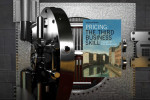The Art and Science of Pricing

Pricing is a creative process. The art of pricing is about selecting a revenue model and pricing strategy. The science of pricing identifies a price based on one or more pricing drivers. Effective implementation of pricing requires a dedicated pricing team.
Pricing: The Third Business Skill: Principles of Price Management by Ernst-Jan Bouter
Pricing: The Third Business Skill illustrates the quantitative, qualitative, and operational sides of pricing. The first part of the book includes a pricing model framework. The last part is primarily concerned with how pricing works and happens in a company.
If you want to understand how pricing functions in an organization and the business processes that are involved, this is a great book. Pricing is often a mystery and this book helps clear away the fog by providing a blueprint for setting up a pricing process and/or team in your company. The book is scrupulously organized and Bouter’s insights flow naturally through the three key themes.
Pricing is both an art and a science: art qualifies, science quantifies. The art is all about choosing a a pricing strategy and revenue model. The science identifies and substantiates the optimum price level, based on pricing drivers.
In the first section of this book, “The art of pricing”, Bouter discusses selecting a business model and lays out various pricing strategies available to select. In the second section, “The science of pricing”, he provides a framework for identifying the optimum pricing level by determining the demand curve. Finally, in “The execution of pricing”, Bouter illustrates how pricing is typically implemented in organizations and gives a recommendation for a better approach.
The science of pricing
The core question of pricing research is: how high is demand for your product or service with certain prices or pricing structures.
There are two commonly used approaches to find determine price sensitivity: asking current and potential customers and observing customer behavior. Directly asking your customers to determine their response to pricing changes will not yield a complete picture. Customers are often unwilling or unable to identify specific factors in buying decisions.
The selection of a business model and price drivers determines what kind of research is required to set optimum prices.
Bouter notes that if you have selected cost leadership as a pricing model, the most important type of research will be cost structure and procurement costs. Similarly, a goal of setting prices based on perceived value requires research related to customer perception and value judgements. The choice of pricing strategy, the “art”, will affect the types of research required to set the price level.
The Pricing Funnel
The core of Bouter’s “science” section is a funnel chart which uses three layers of analysis to determine price sensitivity. The first layer is expert judgement in which a set of experts are polled to provide their best guess on sales volume at various price points. Bouter says “the first layer of the pricing funnel converts beliefs into quantifiable statements about prices”. Their input is analyzed and synthesized to create a informed estimate. This is the most accessible type of pricing analysis as it utilizes in-house expertise and can be done quickly.
The middle layer is implicit measurement in which some proxy for price sensitivity is measured to get an indirect sense of price sensitivity. This layer requires more time and effort and is a step above the first layer in terms of quantification and substantiation. Implicit measurement is based on indicators such as competitor’s prices, competitive features, consumer behavior, and financial metrics. Each price driver (outlined in the “art” section of the book) has corresponding indicators which guide the type of research required.
The third and final layer is explicit measurement—essentially detailed research to create price sensitivity model. This layer requires the highest level of investment and carries the risk of myopia. Because it is so detailed, it is easy to get lost in the details and lose sight of the broader market picture. With explicit measurement, “the ambition is to model all relevant factors and thus make an explicit estimation of price sensitivity based on knowledge of the entire system.” Bouter notes that “the required attention to detail and the laborious nature of working with technical and mathematical models may obscure the view of the bigger picture.”
As you conduct research and ask questions moving down the funnel, the cost increases as well as the specificity. Matching your business model and pricing drivers to research method is key to determining the optimal price level.
Implementing the pricing factory
Responsibilities, skills, and information about pricing are widespread at may companies. An explicit, clear, and broadly supported pricing strategy, however, is often lacking.
The output of the pricing function includes both the pricing model (art) and pricing level (science).
Picking up the challenge he identified at the outset of the book, Bouter describes how to implement a cohesive pricing process in an organization. Bouter diagnoses the distributed nature of the pricing function throughout the organization as the primary challenge with implementing effective pricing. Much of the book is a comparison between the current state of how pricing is implemented in organizations with the future state that portrays an ideal solution.
Everybody has an opinion about the price, but no one is responsible.
Bouter reviews the usual suspects for pricing ownership: sales, product management, marketing, the CEO, and the board. He reviews the motivations and strengths/weaknesses of each option and concludes that none of them is well positioned to own this important function. Moreover, pricing is frequently the second priority for many of the functional teams which are tasked with it.
The most common scenario is that a single executive with oversight for all business functions and profit & loss responsibility is the one who is charged with setting prices. The visibility into all supporting departments and accountability for revenue makes this a traditionally popular choice. His solution is “unity”, a centralized pricing group led by a Chief Pricing Officer which is separate from the aforementioned organizational units.
Balance between specializing in pricing tasks and integrating pricing into other business processes is an essential prerequisite when setting up the pricing function.
When implementing a pricing process within the enterprise, the goal is for the process to be effective, efficient, fast, customer-friendly, reliable, accurate, secure, focused, and strategically relevant. Bouter describes each of these attributes as a checklist with which to review your own implementation and judge operational performance. Each attribute is associated with a few key performance indicators. This framework is another useful tool provided in the book to help implement your own pricing process.
The output of pricing is not limited to the gross price, but extends across all discounts and commercial conditions with financial impact. The output therefore encompasses gross price, discounts, net price, payment term, term of delivery, availability and delivery guarantee.
Bouter breaks down the pricing process into strategic (pricing policy and price guidelines), tactical (pricing structure, discount structure, deal price policy), and operational (price changes, transaction prices). These process levels provide a comprehensive view of pricing activities to use when evaluating your current and future pricing process implementation.
The organizational view makes this book unique–most books on pricing focus on pricing models and levels. Pricing: The Third Business Skills takes the viewpoint of someone who is charged with implementing a pricing process within an organization.






